Statement on Monetary Policy – November 2017 4. Domestic Financial Markets
Consistent with markets offshore, volatility in Australian financial markets remains low as do interest rates, while valuations of ‘riskier’ assets have increased further as investors search for yield. Financial market prices suggest that the cash rate is expected to be unchanged over the next year or so. Australian government bond yields remain at low levels, while equity prices in Australia have risen, after having been little changed since the start of the year. Banks and large businesses have been readily able to raise funding from markets, with spreads of corporate bond yields to government bonds around their lowest levels in 10 years. Business credit growth and bond issuance have both picked up after slowing around the beginning of the year. Housing credit growth has edged lower for both owner-occupiers and investors. The share of new interest-only housing loans declined sharply this year as lenders have responded to the limit on such new lending set by the Australian Prudential Regulation Authority. After increasing a bit earlier in the year, the average housing lending rate on existing loans was little changed over the past quarter, while some lenders have announced reductions to interest rates on selected products for new borrowers.
Money Markets and Bond Yields
The Reserve Bank has maintained the cash rate target at 1.50 per cent since August 2016. Market rates imply that the cash rate is expected to remain unchanged over the next year or so (Graph 4.1).
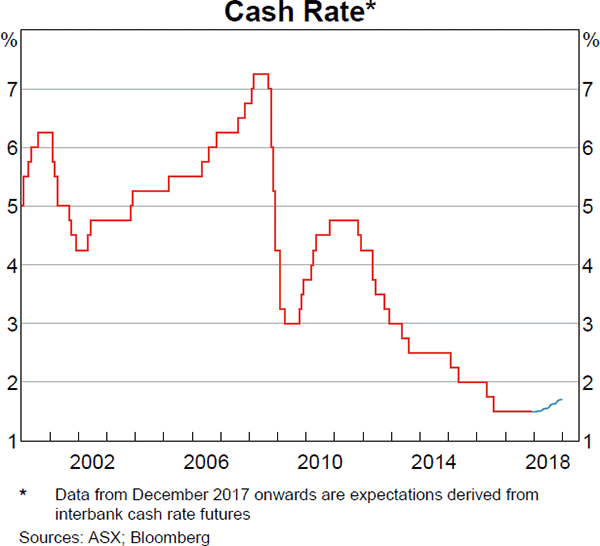
Short-term interest rates in the repurchase agreement (repo) market have increased recently and remain high relative to overnight indexed swaps (OIS) rates. This reflects, among other factors, heightened demand for secured funding from market participants, particularly non-residents. The increase in repo rates appears to be related to developments in the foreign exchange swap market, where Australian dollars can be lent against yen at a relatively high implied Australian dollar interest rate. As a result, some investors have been borrowing Australian dollars under repo to use them for foreign exchange swap transactions.
Yields on 10-year Australian Government Securities (AGS) are around the levels that prevailed at the start of the year, and the spread between 10-year AGS and US Treasury yields remains relatively narrow (Graph 4.2). Recent issuance from the Australian Office of Financial Management and state borrowing authorities has been well-received by the markets.
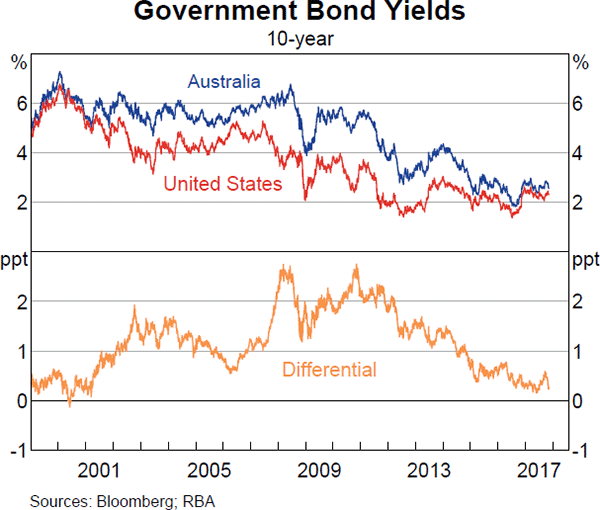
Financial Intermediaries
The overall composition of bank funding was little changed in recent quarters (Graph 4.3). Growth in term deposits has slowed, as banks have lowered interest rates on these products. Banks have also increased their net bond issuance, consistent with favourable conditions in funding markets that have enabled banks to issue for longer terms and at lower cost (Graph 4.4).
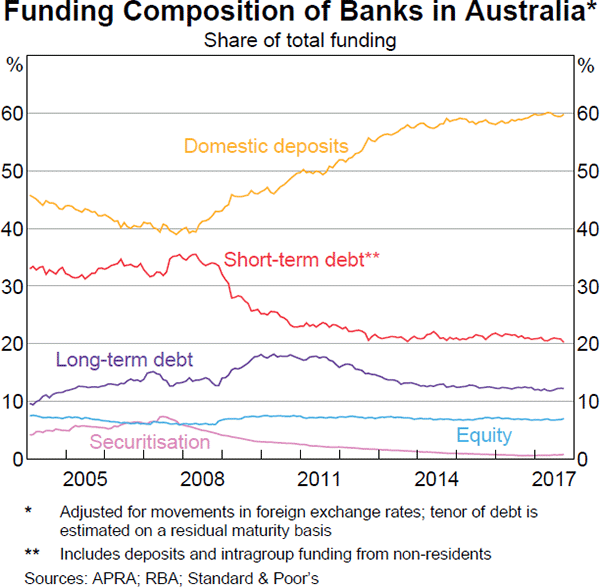
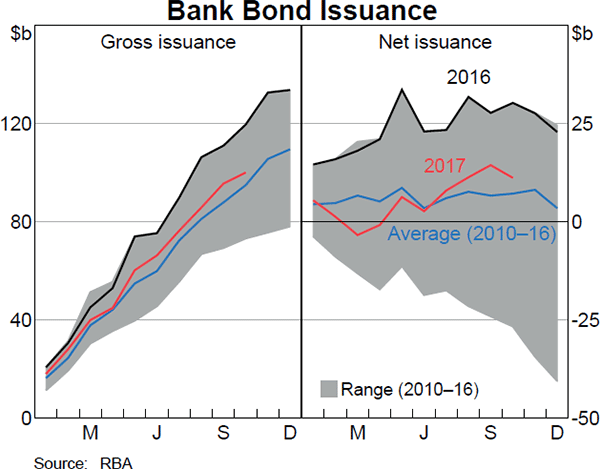
Both deposits and long-term debt are considered to be relatively stable sources of funding for the purposes of the Net Stable Funding Ratio (NSFR) requirement, which will take effect from the beginning of 2018. Under the NSFR, banks are required to hold a minimum level of stable funding for their assets. The major banks have reported that they are comfortably above the regulatory minimum for the NSFR.
Issuance of residential mortgage-backed securities (RMBS) in 2017 has been higher than in recent years. Most RMBS have been issued by smaller banks and non-bank originators (Graph 4.5). Primary market spreads of RMBS to the BBSW benchmark rate have narrowed somewhat over the past year. Narrower spreads combined with an increase in issuance is consistent with growing investor demand in the RMBS market. In liaison, some smaller banks indicated that they intend to maintain a higher level of issuance of RMBS in the near term to boost their capital ratios, diversify their funding base and take advantage of stronger demand for RMBS. A number of smaller banks also noted that the downgrades of their credit ratings in mid 2017 had made RMBS slightly more attractive as a source of funding compared with unsecured bank debt.
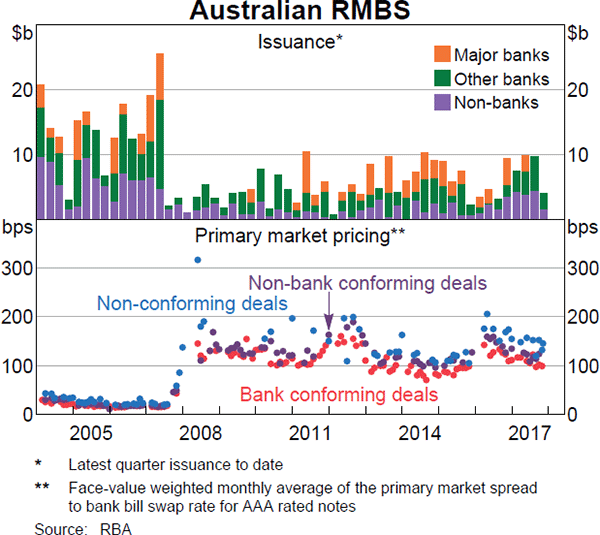
Issuance of hybrid securities picked up slightly over recent months as banks have replaced maturing hybrid issues; hybrid securities remain stable as a share of funding. Hybrid securities have both equity and debt features and can be used to help fulfil regulatory capital requirements. Recent issuance has included large Basel III-compliant Additional Tier 1 and Tier 2 deals offshore by two major banks.
As outlined in the October Financial Stability Review, APRA announced increases in required capital ratios in July in order for the Australian banking sector to be considered ‘unquestionably strong’. APRA has reported that the major banks will need to increase their capital to meet new benchmarks, which will take effect from January 2020. APRA estimates that the major banks should be able to generate this additional capital by retaining earnings, without significantly altering their plans for asset growth or dividend payments, and without undertaking further equity raisings. In recent profit announcements, the major banks reported that their capital ratios had generally increased and in all cases were above 10 per cent. Most other authorised deposit-taking institutions (ADIs) already hold well in excess of the new capital benchmarks.
Debt funding costs have been stable in recent months, after declining a little earlier this year due to lower interest rates for both deposits and debt securities. The reduction in deposit rates largely reflected the maturity of term deposits that were entered into at higher interest rates last year in combination with lower fixed rates on new term deposits. The cost of major banks' outstanding long-term wholesale debt funding is expected to continue to decline, with the cost of new long-term debt below that of outstanding debt. Indeed, bank bond spreads at issuance are around their lowest level in the past two years (Graph 4.6). The cost of hybrid issuance has also fallen this year.
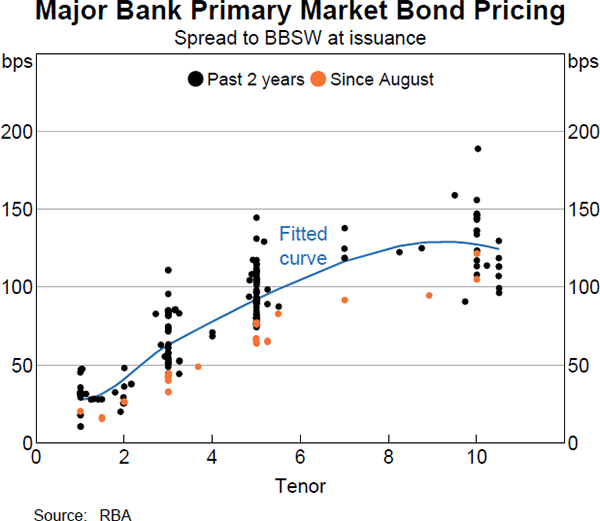
The cost of short-term wholesale funding has also declined over the year to date, although this has been partly reversed over the past few months (Graph 4.7). The decline in bank bill rates relative to OIS earlier in the year reflected lower issuance. This was associated with a number of factors that made it relatively less attractive to issue bank bills in the domestic market, including a decline in the cost of short-term offshore funding and strong growth in deposits. Since mid 2017, 6-month bank bill rates have risen and 3-month bank bill rates have stabilised as the factors lowering rates in the first half of the year have partially unwound.
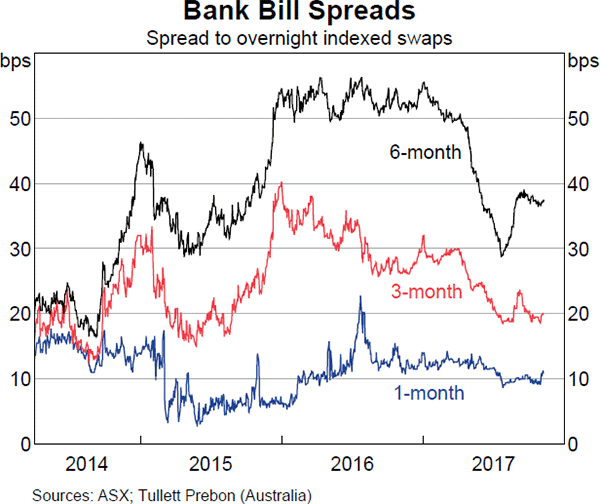
The implied spread between lending rates and debt funding costs for the major banks is estimated to have been relatively stable in recent months. This follows an increase in the first half of the year in response to a small increase in the average housing interest rate and slightly lower debt funding costs.
Financial Aggregates
Total credit growth has remained steady as growth in business credit has picked up since earlier in the year, while housing credit growth has edged lower (Graph 4.8). Broad money has grown a little faster than total credit over the past year, although recently it has slowed a little as deposit growth has slowed (Table 4.1).
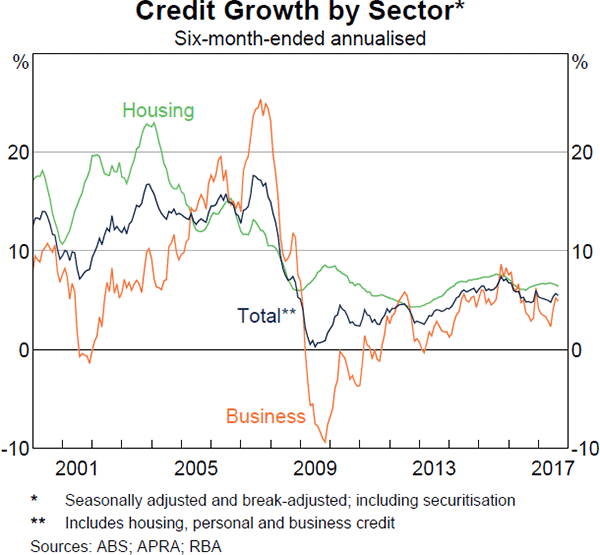
| Three-month ended | Year-ended | ||
|---|---|---|---|
| June 2017 | Sept 2017 | Sept 2017 | |
| Total credit | 1.5 | 1.2 | 5.4 |
| – Housing | 1.6 | 1.5 | 6.6 |
| – Owner-occupier | 1.7 | 1.6 | 6.3 |
| – Investor | 1.5 | 1.3 | 7.2 |
| – Personal | −0.2 | −0.3 | −1.0 |
| – Business | 1.5 | 1.0 | 4.3 |
| Broad money | 2.1 | 0.4 | 6.8 |
|
(a) Growth rates are break adjusted and seasonally adjusted Sources: APRA; RBA |
|||
Household Financing
Housing credit growth has edged lower in six-month annualised terms, with a notable decline in investor credit growth this year and a slowing in owner-occupier credit growth more recently (Graph 4.9). This follows an increase in owner-occupier credit growth earlier in the year, largely concentrated in NSW and Victoria, while the decline in investor credit growth has been broadly based (Graph 4.10).

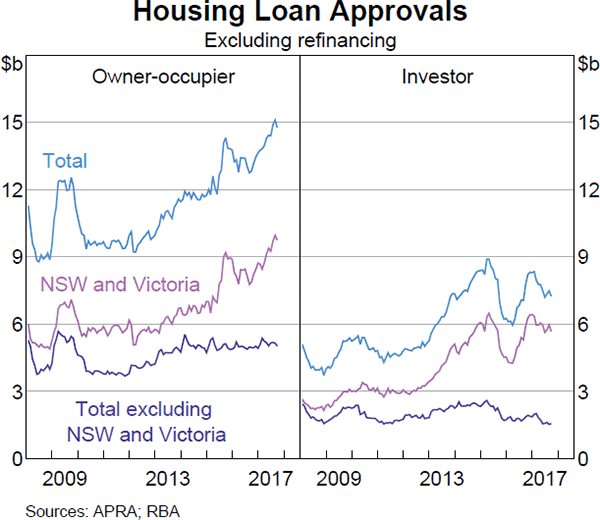
The share of housing loan approvals with interest-only payments has declined sharply, averaging less than 20 per cent in the September quarter, down from around 35 per cent in 2016. This share has declined most notably for investors, which, however, remains higher than the share for owner-occupiers (Graph 4.11). In addition, banks have reported that some existing borrowers are continuing to switch from interest-only to principal-and-interest loans in response to the interest rate differential that now exists between these loan products. With many lenders below APRA's limit of 30 per cent for the interest-only share of new lending, some lenders have announced reductions in interest rates on fixed-rate loans with interest-only repayments.
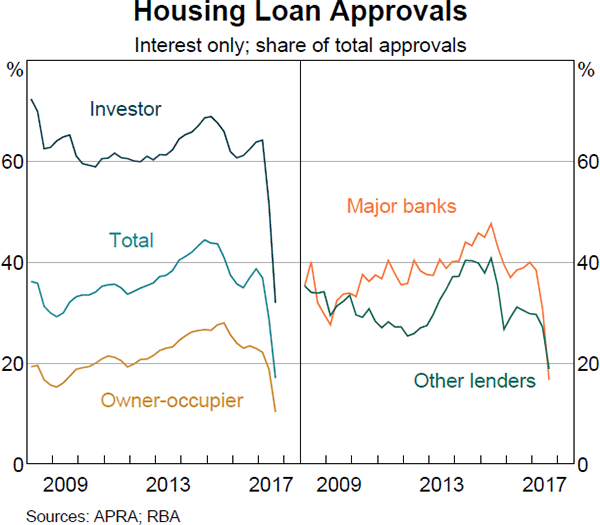
Slower growth in housing lending by the major banks over the past six months was largely offset by stronger growth from other lenders (Graph 4.12). This partly reflected the need for the major banks to reduce their interest-only lending by more than the other lenders in order to comply with APRA's limit. One factor constraining credit growth for some smaller lenders is their capacity to process an increased volume of applications in a timely manner. Non-ADI lenders have also accounted for a larger share of housing credit growth in recent years, although these lenders are estimated to account for less than 5 per cent of the stock of outstanding housing credit. Proposed changes to APRA powers introduced to the Australian Parliament in October will enable more comprehensive measurement of the provision of credit by non-ADIs.
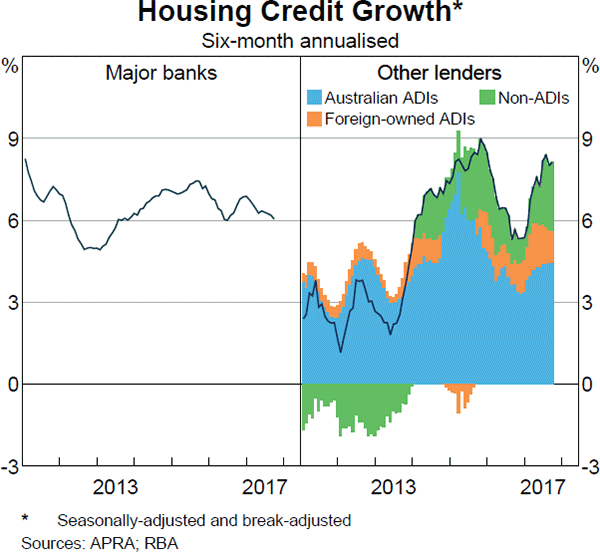
There has been faster growth in the supply of new dwellings in recent years. Accordingly, lending approvals to households for the purposes of building or purchasing a new dwelling have continued to grow this year, while lending approvals for purchasing or refinancing existing dwellings have been steady.
Housing lending rates
Standard variable reference rates (SVR) on housing loans have been stable in recent months. This follows increases for investors and interest-only borrowers earlier in the year and declines for owner-occupiers with principal-and-interest loans. Data on securitised mortgages reported to the RBA indicate that the average rate for outstanding housing loans has risen by around 10 basis points since November 2016 (Graph 4.13; Table 4.2). This increase in outstanding housing interest rates is noticeably less than the increase in SVRs over that period.[1]
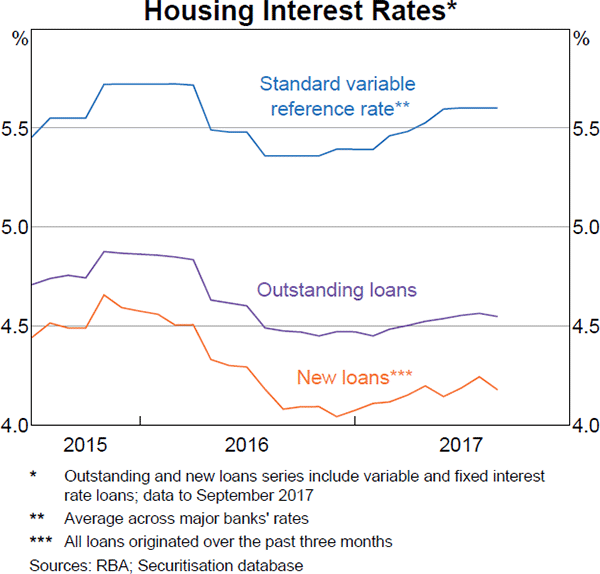
| Interest rate Per cent | Change since November 2016 Basis points | |
|---|---|---|
| Housing loans(a) | ||
| – Variable principal-and-interest rate | ||
| – Owner-occupier | 4.33 | −7 |
| – Investor | 4.77 | 17 |
| – Variable interest-only rate | ||
| – Owner-occupier | 4.76 | 45 |
| – Investor | 5.11 | 62 |
| – Fixed rate | ||
| – Owner-occupier | 4.30 | −23 |
| – Investor | 4.40 | −21 |
| – Average outstanding rate | 4.55 | 10 |
| Personal loans | ||
| – Variable rate(b) | 11.63 | 14 |
| Small business | ||
| – Term loans variable rate(e) | 6.43 | 4 |
| – Overdraft variable rate(e) | 7.31 | 4 |
| – Fixed rate(c)(e) | 5.29 | −1 |
| – Average outstanding rate(d) | 5.28 | −7 |
| Large business | ||
| Average outstanding rate(d) | 3.39 | −10 |
|
(a) Average rates from Securitisation Dataset, data to September 2017 Sources: ABS; APRA; Securitisation System; RBA |
||
The increase in the average rate on all loans is less than the rise in SVRs for several reasons. First, interest rates on new variable-rate loans are, on average, below those on outstanding loans. This gap exists because the discounts that lenders apply to the SVRs have tended to increase over time. For example, the increases in interest-only and investor SVRs this year have been partly offset by larger discounts (Table 4.3).
| 2015 | 2016 | 2017 | |
|---|---|---|---|
| Owner-occupier | |||
| – Principal and interest | 1.0 | 1.2 | 1.2 |
| – Interest only | 1.1 | 1.2 | 1.3 |
| Investor | |||
| – Principal and interest | 1.1 | 1.2 | 1.3 |
| – Interest only | 1.1 | 1.2 | 1.4 |
|
(a) RBA estimate Sources: Banks' websites; RBA; Securitisation Database |
|||
Second, the average interest rate on all fixed-rate loans has fallen by around 20 basis points over the year, since the interest rates on most new fixed-rate loans are below those on existing and maturing loans (Graph 4.14). In addition, some lenders have recently announced reductions in interest rates on fixed-rate loans for investors.
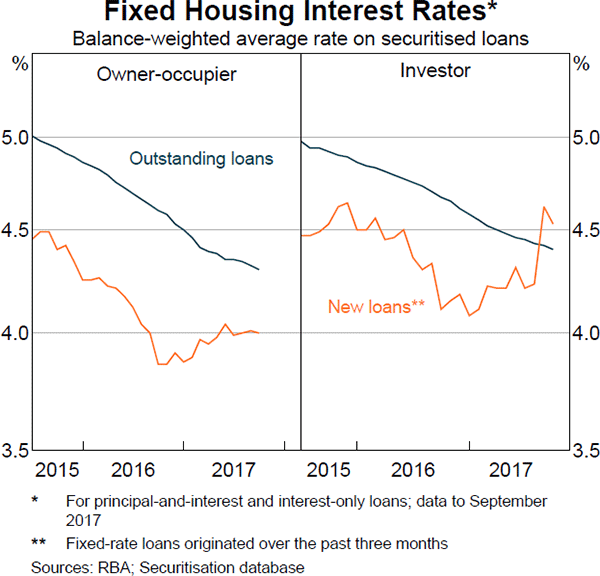
Third, some existing borrowers have switched their repayment terms from interest-only to principal-and-interest to obtain lower interest rates (Graph 4.15). In addition, an increasing share of borrowers are choosing fixed-rate loans, for which interest rates have continued to decline.
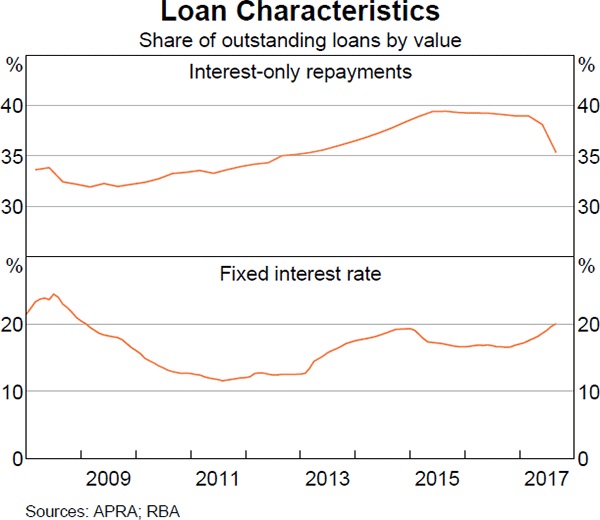
Business Financing
Growth in a broad measure of business debt picked up in the past six months, reflecting higher growth in business credit, corporate bond issuance and syndicated lending by foreign institutions (Table 4.1; Graph 4.16). The increase in corporate bond issuance has been driven by infrastructure and utilities companies (Graph 4.17). In contrast, net equity raisings have been relatively subdued this year.
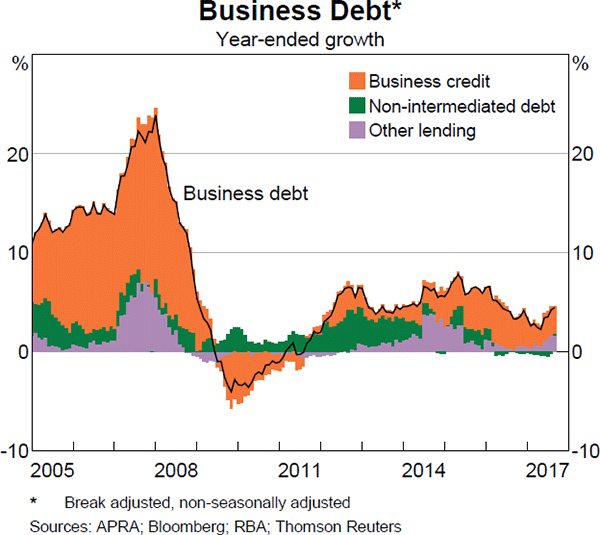
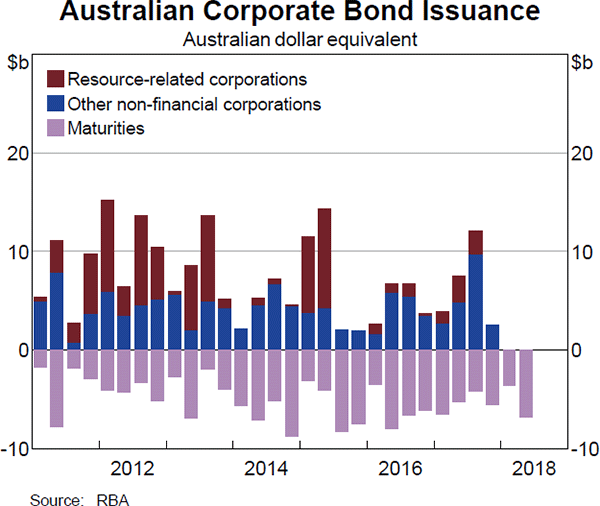
The growth in business credit over the course of this year reflects ongoing strength in lending by foreign banks. The major banks' share of new business loan approvals remains low relative to recent years, reflecting both foreign competition and efforts by some major banks to reduce exposures to selected industries and larger companies. Business lending by Chinese banks continues to grow rapidly, with the share of this lending in total business credit now more than 3 per cent, up from around 1 per cent in 2012.
Demand for new lending remains mixed across industries (Graph 4.18). There has been a pick-up in loan approvals for finance and insurance and other service industries such as education, health and tourism. Meanwhile, loan approvals for the retail trade sector have declined, with many lenders adopting a cautious outlook for traditional bricks-and-mortar retailers. While some lenders have reported concerns over property valuations, property lending has increased in recent months, including for residential development.
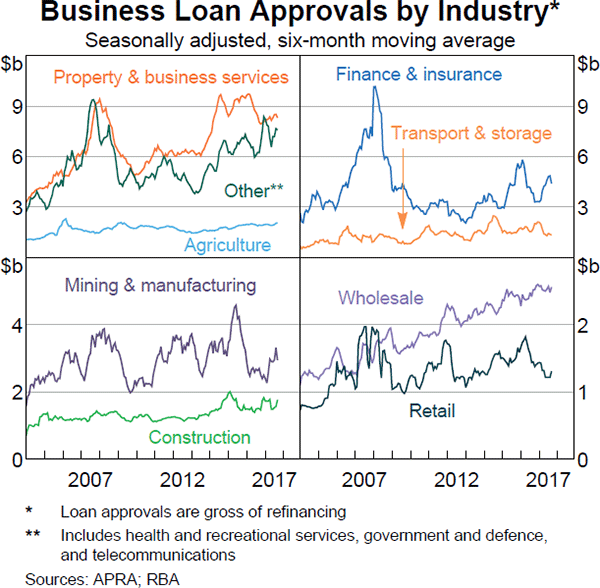
Business lending rates on outstanding loans to small and large businesses have decreased slightly this year (Graph 4.19). Also, corporate bond spreads (relative to yields on AGS) have continued to narrow, with this trend broad based across industries and credit-rating bands (Graph 4.20).
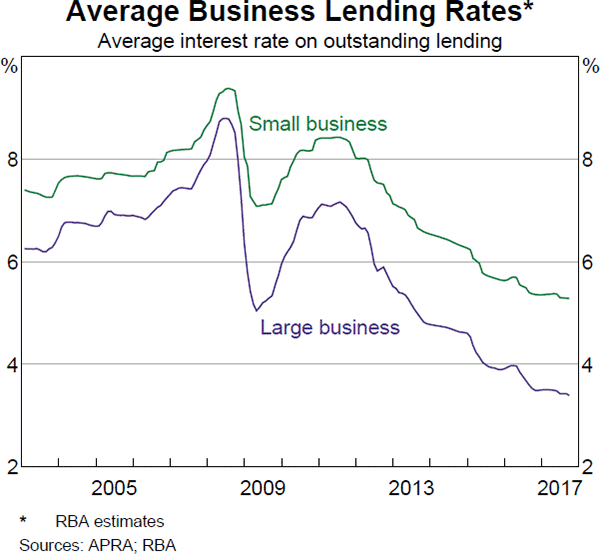
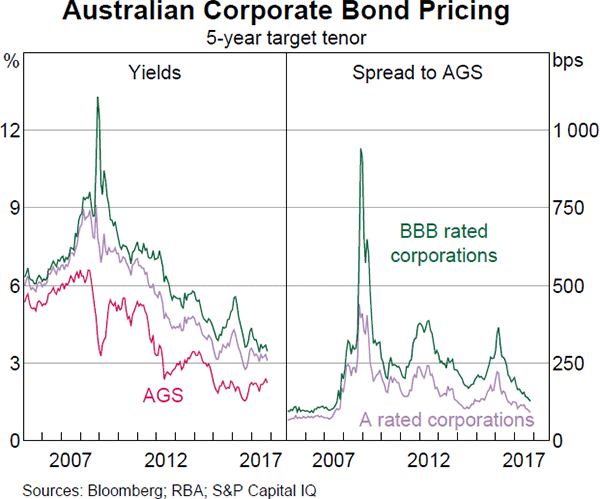
Corporate Profits and Balance Sheets
The underlying profits of ASX 200 companies rose in the first half of 2017, but were slightly below consensus expectations (Graph 4.21). The increase was largely driven by resources sector profits, which were boosted by higher commodity prices. The large mining companies reported that they would use these higher earnings to increase their dividends and reduce their debt.
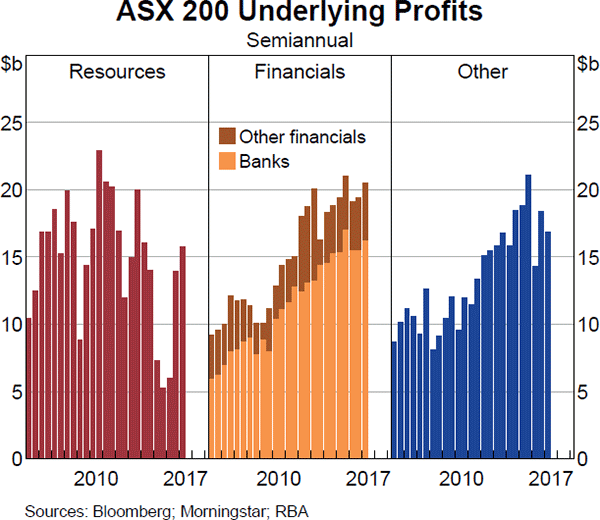
The financial sector also reported an increase in profits, with particularly strong earnings results from non-banks. Earnings in the banking sector were supported by higher net interest income, slow growth in expenses and a decline in charges for bad and doubtful debts. Growth in net interest income reflected growth in average interest-earning assets and a rise in the net interest margin.
Aggregate gearing for listed non-financial corporations continued to decline, reflecting a reduction in debt. Gearing in the resources sector declined, as higher cash flows in the mining sector were used to pay down debt (Graph 4.22). Gearing in the real estate sector also declined, with property revaluation gains boosting assets. Conversely, gearing in the infrastructure sector continued to increase.
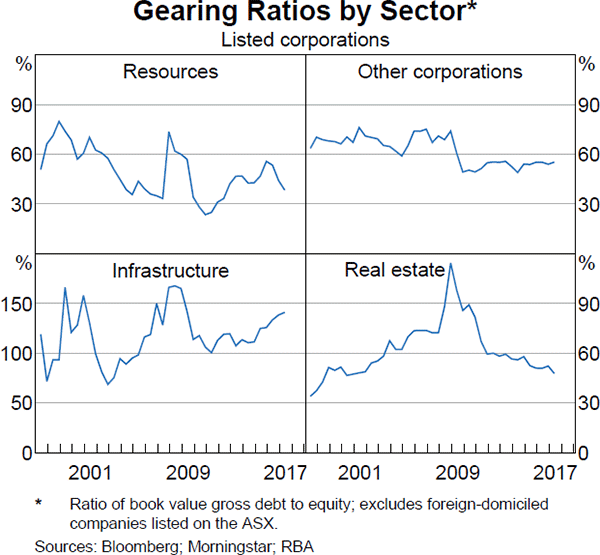
Equity Markets
After having been little changed since the start of the year, Australian equity prices have recently increased alongside higher equity prices in global markets (Graph 4.23). This increase has been broad based across sectors. Resources sector share prices have increased in recent months, notwithstanding lower iron ore prices.

Analysts' earnings expectations for ASX 200 companies have been revised higher, particularly in the resources sector. Resources sector valuations (as measured by forward price-earnings ratios) have continued to track around their long-term average (Graph 4.24). Valuations across the other sectors have been little changed.
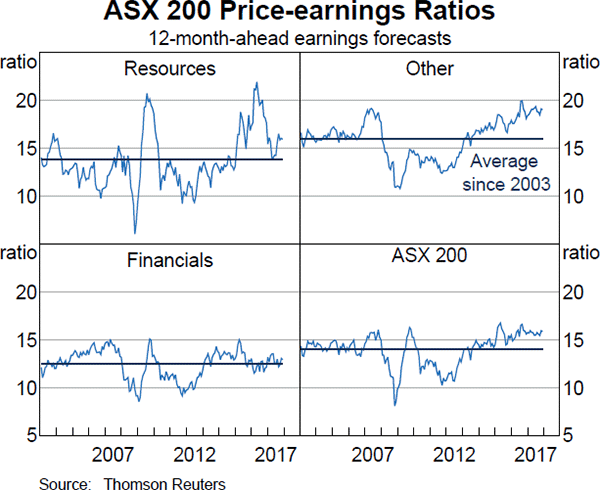
Footnote
The Securitisation Dataset covers a significant share of the market for housing loans and provides useful indicators of developments in home lending, although loans in the dataset may have different characteristics from those not covered by the dataset. See Kent C (2017), ‘Some Innovative Mortgage Data’, Speech at Moody's Analytics Australia Conference 2017, Sydney, 14 August. [1]